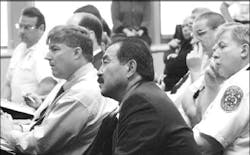Fire-Rescue Reform Passes Unanimously in Montgomery County, Maryland
The council spent six months -- five hours on Tuesday alone -- debating changes to the fire and rescue system. The reform bill was introduced in October by Councilman Michael J. Knapp (D-Dist. 2) of Germantown, who crafted the bill.
The bill creates two county-paid division chiefs -- one overseeing career firefighters and one overseeing volunteers -- who will report to the fire chief. It also gives volunteers a county-paid advocate whose role will be similar to the one the career firefighters union plays in negotiations.
Another key provision allows the fire chief to transfer equipment purchased at least partly with tax money as well as commandeer facilities or equipment if a local department refuses to provide service. Apparatus paid entirely by the volunteer corporations would not be transferred without approval, except in an emergency.
County Executive Douglas M. Duncan (D) praised the council's action, saying in a statement Tuesday that the legislation "improves a complicated and disjointed fire and rescue system that is in desperate need of simplification in this post-9-11 world. ... I look forward to reviewing the final bill over the next several days."
The reform is slated to go into effect Jan. 1.
The vote by the nine-member council came after morning and afternoon discussions that repeatedly appeared headed for a stalemate amid struggles to give more power to the career fire and rescue system or preserve power of the 19 volunteer fire and rescue departments.
Volunteer organizations established and own most of the county's fire stations and purchased much of their equipment, but about 950 paid county firefighters answer the majority of calls.
The volunteers claim about 1,500 members, at least 500 of whom are active on calls.
Arguments about whether the county needs to put its combination volunteer-paid system under a streamlined command structure have simmered for decades.
But people on both sides of the debate said Tuesday that they hoped the bill would avert a threat by volunteers to take the issue to referendum in November.
W. John Luper, volunteer chief with Gaithersburg-Washington Grove Volunteer Fire Department, said the volunteers' concession of agreeing to a single, uniformed fire chief is significant because it is something that voters had shot down several times in the past. Luper said, however, that he may support a referendum if volunteers are not satisfied with the reform.
"If we see it doesn't do well for the fire service, I don't think we have a choice than to go to the public," he said.
Early on Tuesday, the referendum threat appeared real when efforts to craft a compromise broke down over a proposal that sought to address the sorest point for volunteers: ensuring that local volunteer chiefs have the same rank as the two new division chiefs.
The council rejected that proposal, in keeping with objections from the Duncan administration.
"It flies in the face of the intent of the bill [which is] that division chiefs would be superior in rank," said Bruce F. Romer, the county's chief administrative officer.
"The biggest thing is [the reform bill] creates a unity of command and identifies a chain that flows from the fire chief to the two division chiefs to the local chiefs," Romer said after the vote. "And that's an organization that I think will pay dividends."
The Fire and Rescue Commission will continue to have appellate authority on discipline matters only and will review and approve policy as proposed by the fire chief.
Maintaining the commission was the biggest compromise the career firefighters made, said Stephen R. Jones Jr., an operations captain with the county fire and rescue service.
But policymaking will be easier under the new system, he added.
The bill is not a move away from the county's traditionally combined system, Jones said.
"It actually strengthens the combined system," he said.
Andrew B. White, chairman of the Montgomery County Fire Board and a member of the Community Volunteer Fire and Rescue Association, said the volunteers' biggest compromise was the creation of a single chief.
"We've long felt that this is something that was not necessarily essential to the future," he said. "But we also recognize that it's not going to detract from our work to serve our communities."
Michael J. Weiner, president of the Community Volunteer Fire and Rescue Association, which represents 18 of the county's 19 fire departments, disagreed with criticism by Fire Administrator Gordon A. Aoyagi and some council members that the Fire and Rescue Commission had been ineffective. Aoyagi made an issue of the fact that the commission took a year to adopt an emergency response protocol.
Weiner and other volunteers insisted that, despite the squabbling over authority at a fire scene or accident, the conflict has not affected the quality of service.
"The tensions that have affected the outcome of an incident are of such a miniscule percentage it doesn't register on the Richter scale," Weiner said.
Volunteers have grown to distrust county government, he said, because of constant "attempts to undermine and denigrate the contributions of volunteers.
Paid firefighters, on the other hand, have complained that volunteers are "hobbyists" who control too much of the system to the detriment of operations.
